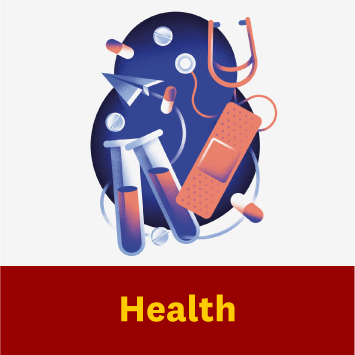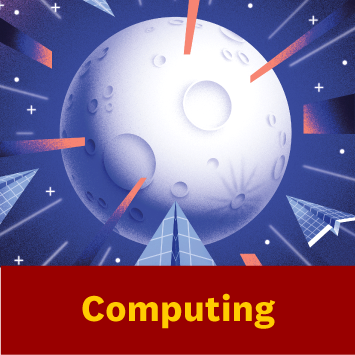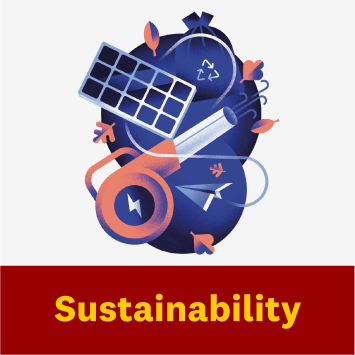Four groups — women, adults 45 and older, those living in poverty and people with metabolic syndrome — are possibly driving this increase, a USC study finds.
Category: Uncategorized
New wearable sensor made at USC could help bipolar patients track medication levels through sweat
The sensor, believed to be first of its kind, could vastly improve treatment and drug safety for millions of patients who take lithium for bipolar disorder.
USC Leonard Davis School faculty honored for research, mentorship
Dean Pinchas Cohen and Vice Dean Sean Curran are recognized for extraordinary work in aging by the Gerontological Society of America.
Mission: Possible
USC President Carol Folt’s ambitious “moonshot” goals have helped cement the university’s position as a leader in advanced computing, health sciences, athletics and more. (Illustration/Daniele Simonelli)
University
Mission: Possible
When USC president Carol Folt outlined her ambitious “moonshot” plans, she knew they would make USC a top destination for students, faculty and staff seeking purpose-driven work, collaborative learning and innovative discovery.
USC President Carol Folt shared her vision for her “moonshots” at her first in-person State of the University address in 2022: “I see these as bold, comprehensive strategies for cross-institution collaboration in key areas.” By creating the roadmap for USC’s future and leveraging its unrivaled scale, size, breadth and excellence, Folt has set the university on the path to becoming America’s “school of schools.” Read on to learn just how much these ambitious initiatives have achieved.
FRONTIERS OF COMPUTING
The USC Frontiers of Computing initiative is a $1 billion-plus investment that builds on USC’s 50-year legacy of innovation, leveraging its leadership role in advanced computing research in artificial intelligence, machine learning and data science. It positions the university as an incubator for talent that can apply high-tech solutions to some of the world’s biggest challenges. The initiative calls for an infusion of artificial intelligence into all of the university’s schools to spark innovation, creativity and collaboration for the good of society.
-
- The university launched its 23rd school, the USC School of Advanced Computing, within the USC Viterbi School of Engineering. USC also plans a bigger footprint in Silicon Beach in the West L.A. area. Its offerings will also emphasize the importance of the ethics of technology, especially in the field of AI.
- USC is the No. 1 research university in the country in overall computer science degrees conferred.
- The initial $260 million investment for the moonshot included funds to hire new faculty, made possible because Folt reimagined a gift from the Lord Foundation of California; the Thomas Lord Department of Computer Science at the USC Viterbi School of Engineering was thus renamed.
- The USC Center for Generative AI and Society launched in 2023 to focus on USC’s leadership in the ethical use of generative AI in disparate disciplines — even the arts and education.
- USC + Amazon Center on Secure and Trusted Machine Learning supports research and new approaches to machine learning privacy and security.
- Dr. Allen and Charlotte Ginsburg Human-Centered Computation Hall houses the Thomas Lord Department of Computer Science and the USC School of Advanced Computing.
- The USC Marshall School of Business launched the Business of Blockchain Initiative to accelerate research, teaching and industry engagement in the field.
- Andrew Viterbi gave the USC School of Advanced Computing $10 million for the hiring of faculty and distinguished chairs.
- The School of Advanced Computing created an endowed chair in computer science and health, made possible by a $5 million gift from entrepreneur and philanthropist Mark A. Kolokotrones.
The world needs engineers and computer scientists to solve the grand challenges we face. The new school will tackle this goal by developing reimagined engineering curricula that also emphasize the ethics of technology in our fast-changing world.
— Dean of the USC Viterbi School of Engineering Yannis C. Yortsos
HEALTH SCIENCES 3.0 
Through the Health Sciences 3.0 moonshot, Folt created the Office of Health Affairs and hired physician-scientist Steven Shapiro as the first senior vice president for health affairs to supercharge collaboration among USC’s five health schools and its academic medical system, Keck Medicine of USC. The initiative also takes advantage of the AI revolution and collaborative care to overcome the greatest challenge of health care: providing improved outcomes at an affordable price.
By catalyzing groundbreaking, team-based research and education — in varied fields such as oncology, Alzheimer’s, aging, cardiac care and artificial intelligence — to tackle health care’s biggest challenges, the university’s health system has transformed care for USC’s surrounding communities and patients worldwide.
-
- The USC health enterprise saw significant growth during Folt’s tenure, including an eastward expansion with the 2022 acquisition of USC Arcadia Hospital in the San Gabriel Valley, transplant clinics in Las Vegas, and new clinical locations in Pasadena.
- In 2022, Folt directed $50 million from the Alfred E. Mann Foundation for Biomedical Engineering gift to name the USC Mann pharmacy school and $35 million to name the Mann department of biomedical engineering.
- A $50 million joint gift to USC and the University of California, San Diego, from the Epstein Family Foundation in 2022 supports existing Alzheimer’s research and accelerates collaborative efforts to discover effective therapies and a cure.The donation established the Epstein Family Alzheimer’s Research Collaboration at both universities and enabled the creation of the USC Alzheimer’s Therapeutic Research Institute.
- In 2024, the Weise family gave the Glendale Eye Medical Group to the USC Roski Eye Institute, expanding USC eye care services in the area. The gift established USC Roski Eye Institute-Glendale and brought six new faculty members to the institute, including ophthalmologists specializing in glaucoma, retina and comprehensive eye care, as well as three optometrists.
- Leonard D. Schaeffer and his wife, Pamela, have donated $59 million to establish the USC Leonard D. Schaeffer Institute for Public Policy & Government Service, which will expand two outstanding programs — the USC Schaeffer Center for Health Policy & Economics and the Leonard D. Schaeffer Fellows in Government Service.
- A $10 million gift from USC Trustee Mark Stevens and Mary Stevens, his wife, established the USC Mark and Mary Stevens Center for Orthobiologics to accelerate research into treatments for arthritis and joint injuries.
We are realizing the future of medicine with research-based inputs combined with AI, brilliant minds and compassionate caregivers to deliver tomorrow’s medicine today.
— USC Senior Vice President for Health Affairs Steven Shapiro
 SUSTAINABILITY
SUSTAINABILITY
USC’s Sustainability moonshot marshals the university’s research, teaching and community engagement efforts to create a healthy, just and thriving world.
USC has made substantial progress on sustainability since Folt became president in 2019. The president also created the Presidential Working Group on Sustainability in Education, Research, and Operations and hired the university’s first chief sustainability officer, Mick Dalrymple, in 2021 to optimize and grow the university’s sustainability efforts through collaboration across the USC community.
Folt’s campaign, Assignment: Earth, serves as a blueprint for action on sustainability across the university and promotes a more sustainable future.
-
- USC announced a new curriculum initiative designed to incorporate sustainability across disciplines. The university now offers more than 840 sustainability-related courses.
- When USC groundskeepers switched to electric-powered mowers, leaf blowers, hedge trimmers and chainsaws, the American Green Zone Alliance certified the USC University Park Campus as a “green zone” — the first campus in the country to earn the honor.
- In 2022, USC banned single-use plastic beverage bottles, keeping more than 5 million bottles out of landfills to date. Instead, Trojans fill up via hydration stations, water coolers/dispensers and water fountains.
- A new 1,500-square-foot Sustainability Hub at the University Park Campus opened in 2023 to become home to Assignment: Earth and other sustainability projects. It was also where the inaugural Presidential Sustainability Fellows were announced — postdoctoral researchers who pursue multidisciplinary projects and work out of the hub.
- The President’s Sustainability Internship Program currently provides 19 students with real-world work experience applying their classroom education to develop operational sustainability solutions using the USC campuses as living labs.
- Every year starting in 2021, USC has earned a silver rating or higher in its Sustainability Tracking, Assessment and Rating System (STARS) report, a benchmark for more than 1,000 U.S. colleges and universities, tracking how institutions address the environmental, social and economic aspects of sustainability. USC earned a gold rating in 2024.
- Keck Medicine of USC practitioners have overhauled procedures in operating rooms to significantly reduce the use of anesthetics that harm the environment and replace disposable devices and materials with reusable alternatives when possible.
- USC professors not only study sustainable solutions but have also incorporated more sustainable processes, materials and equipment into their work. This includes techniques by scientists at the USC Dornsife College of Letters, Arts and Sciences to make chemical research labs greener and more energy efficient by using safer chemicals, preventing pollution and properly disposing of waste.
- The USC Urban Trees Initiative, with support from the Bezos Earth Fund, brings the Trojan community together to make strategic decisions about building a resilient urban forest in L.A.
- USC decreased water usage by 25% by installing meters at the University Park and Health Sciences campuses and fixing leaks on a quicker timeline.
- USC has reduced greenhouse gases on both campuses by 50% since 2014.
- USC has increased campuswide waste diversion to 54%; USC Hospitality has increased the amount of food purchased from sustainable sources to 55%; and the university reduced its lighting load by 60% by switching to energy-efficient LED lighting.
- In 2024, the USC Wrigley Institute for Environment and Sustainability received a $4 million commitment from Ballmer Group to launch a new initiative focused on climate and carbon management.
As an anchor institution in L.A. with global reach and impact, USC has an opportunity and obligation to research and develop interdisciplinary sustainable solutions, to equip students with the tools to weave those solutions through- out society in their chosen field, and to practice those solutions within our own campuses.
— USC Chief Sustainability Officer Mick Dalrymple
 REIMAGINING ATHLETICS
REIMAGINING ATHLETICS
The Reimagining Athletics moonshot empowers student-athletes across the university’s 23 sports programs to compete with integrity at the highest level athletically and in the classroom. The initiative — which builds on the current success of Trojan athletic programs — aims to improve USC’s facilities and maximize space use through innovative planning. Under Folt, USC has experienced its most transformational era of investment in athletics facilities upgrades in the university’s history.
-
- The moonshot was announced as the university made its historic move to the Big Ten Conference in 2024, which meant additional resources and nationwide exposure for Trojans.
- Faculty, staff and students now benefit from being part of the 18-member Big Ten Academic Alliance, which facilitates the sharing of resources, infrastructure and expertise.
- The moonshot has provided first-in-class academic support through key hires, doubled the number of sport psychology clinicians, integrated athletic medicine through Keck Medicine of USC and improved nutritional offerings given to student-athletes. The university also launched the Trojan Enrichment Program, which allows the maximum amount of education-related financial support to all student-athletes.
- USC’s student-athlete graduation success rate was 94% in 2024, the highest in school history. Thirteen of the university’s sports programs had a rate of 100% during that time.
- Colich Track and Field Center opened in 2021 as the new home of the men’s and women’s track and field programs, including a Hall of Fame showcasing the programs’ impressive success in NCAA championships and the Olympics.
- Allyson Felix Field was renamed in 2023.
- Rawlinson Stadium was established for the USC women’s lacrosse and soccer teams in 2023 after a gift from the Fritz B. Burns Foundation was paired with support from Folt’s presidential fund and other donors.
- USC completed an 18-month, $315 million renovation of the L.A. Memorial Coliseum during Folt’s tenure.The significant remodeling includes a state-of-the-art press box, new seats throughout the stadium and an updated locker room for the home team.
- A $50 million gift from the Ronald H. Bloom family in late 2024 brought investments in athletics facilities during Folt’s presidency to more than $200 million so far.The gift will fund the Bloom Football Performance Center.
- Folt commissioned a makeover of the Galen Center in 2024 to enhance the game day experience.
- Dedeaux Field, the home of USC baseball, will see significant enhancements, including upgraded capacity, a team meeting space, a brand-new press box, coaching and support staff offices, and fan experience enhancements.
- The John McKay Center will receive future innovations for all student-athletes, including an expanded dining facility and an upgraded golf practice facility.
Being a member of the Big Ten will enable us to further invest in the student-athlete experience by providing us with additional resources; to create exciting new rivalries with like-minded institutions; to celebrate and share our storied traditions with Trojans across the country and with new generations of fans; and to provide our student-athletes and university with unprecedented national exposure and opportunities.
— USC Athletic Director Jen Cohen
USC COMPETES
The USC Competes moonshot allows USC to recruit, retain and support students, faculty and staff. By becoming a national leader in accessibility, affordability and debt reduction, the university can draw the best and brightest students to thrive and reach their academic, professional and personal dreams. USC Competes also encapsulates the university’s goal to lead in progress and innovation.
-
- Within three months of her tenure at USC, Folt established her Affordability Initiative.
- In the last six years, USC saw 69 faculty inducted into the national academies of medicine, engineering, sciences, inventors and education, as well as the American Academy of Arts and Sciences.
- In 2023, the university launched Advise USC, which enables all academic advisors across USC’s 23 schools to use the same system, ensuring students receive consistent guidance throughout their time at USC.
- The President’s High-Tech Scholars Program, which was launched with support from the Sherman Fairchild Foundation, as well as Oscar Munoz and Kathy Leventhal, helps tech-interested transfer students from local community colleges thrive at USC through developmental opportunities such as mentorship and a Summer Launchpad Program to support the transition to a four-year university.
- The university launched the Care for the Caregiver program during the COVID-19 pandemic to offer safe places for people to stay while working long hours. This program still exists and provided safety for some Trojans during the January 2025 wildfires.
- The USC Capital Campus expanded the university’s presence and influence in Washington, D.C., in 2023, allowing Trojan students, researchers and alumni to connect and build relationships with the country’s decision-makers. USC has already hosted more than 300 events and conferences since it opened the 60,000-square-foot building.
- Also in 2023, the university joined an exclusive group of just 13 private universities nationwide to surpass $1 billion in annual research expenditures. Folt said during her March 2023 State of the University address that the university has experienced a 44% growth in research spending since 2019, amounting to $1.26 billion in 2024 — a historic high for USC.
- In 2024, Folt led a USC delegation on a three-city tour of India, dubbed “USC-India: Partner the Future.”
We start with our overarching goal — to increase the stature and impact of USC, by making USC the international standard-bearer and innovator for collaborative learning and discovery, and making USC the top choice for students, faculty and staff who seek purpose-driven work and lives.
— USC President Carol Folt at the 2022 State of the University address
 USC ARTS NOW INITIATIVE
USC ARTS NOW INITIATIVE
For decades, faculty, staff and students at USC’s six conservatory-level arts schools and its two museums have contributed to a vibrant environment of creative expression on campus. In 2024, Folt launched the USC Arts Now moonshot to support new, unexpected collaborations throughout the university and connect the arts to every discipline across USC’s campuses.
She also named Josh Kun, professor at the USC Annenberg School for Communication and Journalism and chair in cross-cultural communication, as USC’s inaugural vice provost for the arts, working with USC’s arts deans and USC Museums on partnerships and collaborations across campuses and the greater Los Angeles community that activate the arts and raise Trojan visibility.
-
- Leaders from USC’s arts schools and museums form the backbone of the USC Arts Council to inform the direction of the USC Arts Now initiative. Leaders from the Keck School of Medicine of USC, the USC Center for Generative AI and Society and the USC Arts and Climate Collective are also part of the council.
- Last year, Kun worked with the Keck School of Medicine to bring USC deans and faculty together to explore collaborations between the arts and health sciences.
- In 2024, the USC Arts Now initiative held “Beyond the Human?: From the Metaphysical to the Physical,” co-curated by Kun and renowned artist Cai Guo-Qiang. USC Visions and Voices and the USC Center for Generative AI and Society co-sponsored the event.
- In November, Emmy-winning producer Dick Wolf gave a significant contribution to the USC School of Dramatic Arts.
- In April, USC Arts Now and the USC Thornton School of Music presented a symposium on the pivotal role artists play in responding to crises such as the Los Angeles wildfires.
USC Arts Now focuses on the arts as an interface, as a place of connection between different bodies of thought, different systems of knowing and different disciplines in different fields.
— USC Vice Provost for the Arts Josh Kun
.timeline-nav{position: fixed; bottom: 0; left: 0; background-color: #fff; width: 100%; border-top: 1px solid #ccc; display: flex; justify-content: center; align-items: center; padding: 0 1rem;} .timeline-nav ol {display: flex; list-style: none; margin-bottom: 0; padding: 0;} .timeline-nav li {margin-bottom: 0 !important; margin-right: 2rem; display: flex; align-items: center; padding: 1rem 0; position: relative;} .timeline-nav li:after {position: absolute; content: ‘ ‘; background-color: #990000; width: 100%; height: 6px; top: 0; left: 0; opacity: 0; transition: all 0.2s ease-in-out;} .timeline-nav li:hover:after {background-color: #99000; opacity: 1;}.timeline-nav li:last-child {margin-right: 0;}.timeline-nav a {color: #990000 !important; font-family: “Source Sans Pro”, sans-serif; text-decoration: none !important; font-size: 1.25rem; display: flex; align-items: center;}.timeline-nav a img {margin-right: 10px !important; margin-bottom: 0 !important;}/* Small only */@media screen and (max-width: 39.9375em) {#footer {z-index:20;} .timeline-nav {z-index: 10; bottom: 50px; overflow: scroll; justify-content: normal;}}.hiphop-index{display:flex;width:100%;max-width:975px;flex-wrap:wrap}.hiphop-index .hh-buttons{margin-right:10px;flex:1;text-align:center}.hiphop-index .hh-buttons:last-child{display:block}.hiphop-index .hh-buttons img{width:100%}@media screen and (max-width:600px){.hiphop-index .hh-buttons{flex-basis:33.33%;flex-grow:1;margin-right:auto}.hiphop-index .hh-buttons img{width:100%;padding:5px;box-sizing:border-box}.hiphop-index .hh-buttons:last-child{display:block}}@media screen and (min-width: 768px) {img.alignright{width: revert-layer !important;}}
How USC uses state stem cell funding to train biotech leaders
More than 100 experts credit their training to a California Institute for Regenerative Medicine Scholars program at USC.
Cancer-fighting herpes virus shown to be effective treatment for some advanced melanoma
A genetically engineered herpes simplex virus, when combined with immunotherapy, reduces or eliminates tumors in one-third of clinical trial patients.
Mindfulness meditation can sharpen attention in adults of all ages
In a USC study, 30 days of app-guided meditation were linked to improvements in how quickly and accurately participants directed their focus.
USC cancer survivorship programs help patients thrive post-diagnosis
Kristine Kivuls, Kimiko Yamada, Duncan Wigg and Lauren Vera, from left) discuss Wigg’s progress. (Photo/Glenn Marzano)
University
USC cancer survivorship programs help patients thrive post-diagnosis
Cancer treatments are saving and extending more lives than ever. USC practitioners are guiding patients from diagnosis to treatment to facing their post-care future by connecting them with necessary resources.
When Duncan Wigg, a 79-year-old retired psychologist and professor, developed severe pain in his leg and hip in 2022, he had no reason to expect the diagnosis he would receive.
While his private practice orthopedic physicians initially thought he might need a hip replacement, one physician suspected something more serious might be causing the pain. A PET scan revealed a shocking diagnosis: stage 4 lung cancer.
In the medical journey that followed, that orthopedist referred Wigg to Keck Medicine of USC, where a multidisciplinary team of practitioners would bring him back to health — but not without limitations. Struggling with disabling lymphedema (a buildup of fluid that is common after surgery and cancer treatment) and muscle atrophy post-surgery, Wigg credits oncology physical therapist Kimiko Yamada and her team with helping him return to his normal routines and a new level of health.
With cancer patients living longer than ever due to a stream of new therapies and breakthroughs in research, USC practitioners are redefining post-diagnostic care to help survivors thrive in their new normal.
Through an interconnected web of survivorship programs, practitioners from every corner of the university are guiding patients from diagnosis to treatment to facing their post-care future by connecting them to the necessary resources that give them the best chance for successful therapies and recovery. As patients survive longer, and because the cancer journey is so complex, practitioners coordinate across disciplines to ensure that no patient falls through the cracks — or faces the journey alone.
“Her efforts to reduce the swelling and help me regain my strength were very successful,” Wigg said of Yamada. “Keck Medicine’s coordinated and complementary care helped me overcome the effects of the illness and the effects of the surgery.”
An interconnected web of helpers
Yamada’s entry into the field of oncology came early in her career, when one of her colleagues at the USC Division of Biokinesiology and Physical Therapy had a roster of cancer patients that she needed to share. “I ended up working with her patients and fell in love with it,” said Yamada, who is now an associate professor of clinical physical therapy and the director of the division’s oncology physical therapy residency program.
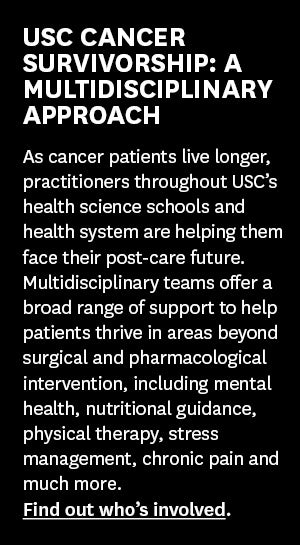
Yamada never gave the roster back and eventually grew her colleague’s practice, becoming a full-time oncology physical therapist and working with a team of surgeons, medical oncologists, radiation oncologists, and speech and occupational therapists. “I don’t think I’ve found that kind of teamwork at any other practice that I’ve been at,” she said.
USC Physical Therapy has a team of oncology specialists that works with cancer patients and survivors to improve quality of life, reduce pain caused by treatments and meet other unique needs of cancer survivors. Therapies include treatment for fatigue, lymphedema and loss of motion; pre- and post-surgical rehabilitation; exercises to improve activities of daily life; and help reducing stress and improving mood, among others.
The program is just one example of how oncology practitioners from USC’s health science schools and health system are providing services to improve quality of life. Those services include mental health care for patients, survivors and their caregivers, as well as support groups to assist patients and those who care for them as they experience the challenges that a cancer diagnosis presents.
Survivorship begins at diagnosis
The survivorship concept — which considers all living patients who have been diagnosed with cancer as survivors — is an international guideline for all providers who work with cancer patients.
“It was developed to recognize that patients who are diagnosed with cancer at any time have a deep number of traumas that they go through that are not just related to their health, but have to do with the financial aspects, with family, their social interactions and what the future looks like,” said Daphne Stewart, medical oncologist with USC Norris Comprehensive Cancer Center and clinical professor of medicine at the Keck School of Medicine of USC. Stewart is also the women’s cancers section chief for medical oncology at Keck School of Medicine’s department of internal medicine.
“There’s a tremendous amount of pressure that gets put on people that we must recognize and address,” Stewart said.
Working within this model, providers like Stewart think about how to work with other providers involved in cancer care, including psychologists, social workers, exercise specialists, and nutrition and weight optimization providers to ensure that patients can take advantage of all the resources the health system offers.
When Stewart arrived at USC in 2023, she developed a clinical breast cancer survivorship program for patients who had finished their primary therapy, including chemotherapy, surgery, reconstruction and radiation therapy. Her team now consists of a medical oncologist, a nurse practitioner who specializes in breast cancer, a social worker and a nurse navigator.
Patients enter the program to improve their long-term mental and physical health and manage financial and social stresses, Stewart said. After speaking with a nurse practitioner, patients are referred to specialists in psychology, psychiatry and physical therapy to engage in therapies designed to help them heal mentally and physically. Survivorship also targets weight loss, blood sugar control and regular surveillance to prevent future cancers. For mental and social support, the program also offers peer groups that meet monthly and give patients a safe space to share experiences.
“It really allows the patients to talk about the overwhelming stress of the big picture of how much this has affected their lives,” Stewart said. Patients discuss cancer-specific changes, such as going through early menopause, chronic pain from treatments, body dysmorphia and other issues.
Stewart remembers a patient who had been lively, social and independent before her breast cancer diagnosis. The experience was traumatic for her, as she received little support from friends and family.
“Being recruited to the survivorship program was a really positive movement forward for her where she could build a bit of a community but also begin to think forward about surviving as opposed to just being focused on all of the side effects and the difficulty of the path that she went through,” Stewart said.
“There are over 18 million cancer survivors in the United States, and over 4 million of these, about 22%, are breast cancer survivors — a number that is expected to rise. We have to acknowledge that this is a large patient population, and as a cancer center, we are thrilled to have a survivorship program so that we can represent our patients fully.”
From survivor to advocate
Mary Aalto, a patient advocate for the USC Norris cancer center, is one of those survivors. A 19-year survivor of stage 3 breast cancer, Aalto returned to the cancer center four years after her successful treatment — at her oncologist’s suggestion — to join the center’s Cancer Survivorship Advisory Council. Soon after, she launched an art series at the center’s cancer resource library featuring the work of survivors with a focus on resilience.
“Survivorship has a lot of recognition now because people are surviving longer,” said Aalto, whose mother died from breast cancer when she was younger. “Twenty, 30, 40 years ago, people weren’t surviving stage 3 cancers, and physicians were just trying to help patients live. Today, survivorship is about quality of life, communication and the doctor-patient relationship.”
Aalto is also the leader of the center’s Patient Perspective Series, a year-round program of events featuring cancer survivors speaking about issues relevant to their peers, including clinical care, physician education, doctor-patient relationships, research, end-of-life laws and resilience. She’s hosted 66 events in her 11 years leading the program.
Aalto says part of the reason she returned as an advocate was the need for patient education and a better understanding of the importance of quality of life as patients, doctors and other medical practitioners craft care plans.
“Despite aggressive treatment, my health is excellent,” she said. “I live in gratitude all the time, and I would not be living in this level of gratitude had I not had cancer. Interestingly, you have to have bad times to appreciate the good times.”
Where courage is born and hope grows strong
Uttam Sinha, director of the Head and Neck Center with Keck Medicine and a professor of otolaryngology — head and neck surgery with Keck School of Medicine, pioneered a survivorship program for his department in the early 2000s.
“Cancer is increasingly becoming a chronic disease; many patients are now surviving longer with cancer in remission,” said Sinha, who echoed Stewart’s belief that society needs to learn how to both take care of and support cancer patients and their loved ones.
He said survivorship programs are essential for providing patients the ongoing care and relevant information throughout their journey — both during and after active treatment.
“There’s so much information in cancer management, but the retention is low because patients are often overwhelmed,” Sinha said. “I usually pair newly diagnosed patients with survivors who’ve been through similar journeys. That peer support is invaluable.”
This mentorship model becomes especially meaningful when patients are facing the physically and emotionally taxing procedures often required in head and neck cancer treatment, such as tracheotomies (to support breathing), mandibulectomies (removal of part or all of the jaw) or glossectomies (removal of part or all of the tongue).
“I understand the process clinically,” Sinha said. “But I haven’t walked in those shoes. A survivor can offer a firsthand perspective — what it feels like, how they coped, how they healed. That’s something only they can truly give.”
The mission statement of the department’s survivorship program, “Where courage is born and hope grows strong,” reflects a core message Sinha and his team promote: encouraging patients to celebrate life, find strength in community and embrace their present, even while acknowledging the losses and uncertainties that accompany survivorship.
The program emphasizes four pillars of well-being: nutrition, stress management, physical activity and sleep.
“The World Health Organization defines health as a complete state of physical, mental, social and spiritual well-being — not merely the absence of disease,” Sinha said. “We tend to focus on physical healing, but the psychosocial aspects are just as important. Our survivorship initiatives aim to nurture those dimensions fully.”
Strengthening patients for the journey
An orthopedic specialist and athletic trainer before becoming a physical therapist, Yamada has now worked in the field of oncology for two decades, helping patients recover better and faster.
“I think everyone has had a loved one, or family member or friend, who has had cancer,” said Yamada, whose grandfathers passed away from cancer while she was in elementary school.
She mentioned that a common misconception is that there is not much to life after cancer and that quality of life is guaranteed to be poor after diagnosis. “I’ll have you know that many of my very first patients from that initial case load are still alive and thriving,” she said.
Optimism in uncertainty
Duncan Wigg’s recovery presents a clear case against that misconception. While he still receives immunotherapy for his initial bout of lung cancer, he describes his health as “excellent.” A little over one year ago, he was diagnosed with pancreatic cancer. After receiving treatment, he faced another painful recuperation but is expected to make a full recovery. He continues to do intensive physical therapy with Yamada, receives regular preventative care with his team of Keck Medicine specialists and takes trips with his wife, a yoga teacher who, he says, was also essential to his recovery.
“I’m a bit of a miracle,” Wigg said. “But the health care system has come so far in research and knowledge in the last 10 years. I experienced nothing but the best collaboration between oncology, general surgery, radiology and physical therapy — they were all talking to each other.”
Mary Aalto shares Wigg’s positivity. “I am so optimistic about the future for cancer survivors, because it’s getting better and better all the time,” she said. “People are living longer. They’re living healthier. They’re regaining the things in their lives that they loved and that they thought they lost when they were first diagnosed.”
USC cancer survivorship: A multidisciplinary effort
At the USC Norris Comprehensive Cancer Center, patient advocate Mary Aalto leads a series of events featuring cancer survivors who are authors, artists, academics and motivational speakers. (USC Photo/Richard Carrasco) 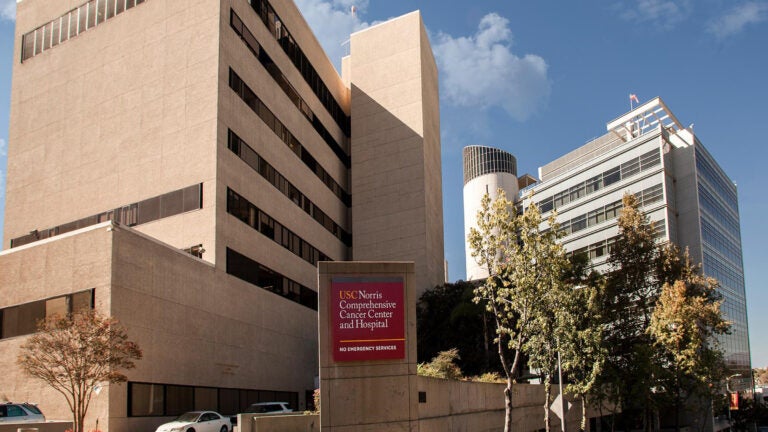
Health
USC cancer survivorship: A multidisciplinary effort
Teams of USC practitioners offer a broad range of support in areas including mental health, nutritional guidance, physical therapy, stress management and chronic pain.
As cancer research and breakthrough treatments help patients live longer, practitioners throughout USC’s health science schools and health system are guiding survivors from diagnosis to treatment to facing their post-care future. Through cancer survivorship programs, multidisciplinary teams of USC practitioners offer a broad range of support in areas beyond surgical and pharmacological intervention to help patients thrive, including mental health, nutritional guidance, physical therapy, stress management, chronic pain and much more. USC units and individuals involved include:
Keck Medicine of USC
USC Head and Neck Center’s patient support group creates a community for patients to share experiences and offer support to each other. The center also has a comprehensive survivorship program, where clinicians from social work to physical therapy to psychiatry work together to provide essential services and support for cancer patients.

The clinical breast cancer survivorship program aims to optimize the long-term mental and physical health of cancer survivors and help them manage financial and social stresses. The program includes interdisciplinary collaboration between clinicians to provide comprehensive oncology support and support groups for survivors and their caregivers.
Keck Medicine’s general Cancer Survivorship Program began in 2014, and provides support to cancer survivors and their loved ones through information and tools to improve and maintain physical health, emotional adjustment and overall well-being. Services include personalized care plans, fertility preservation and restoration, exercise and nutrition support, mental health and wellness support, and other resources.
Keck School of Medicine of USC
Daphne Stewart, clinical professor of medicine at the USC Norris Comprehensive Cancer Center and the Keck School of Medicine and a medical oncologist with Keck Medicine, developed a clinical breast cancer survivorship program in 2023 for patients who had finished their primary therapy, including chemotherapy, surgery and reconstruction. Her team consists of a medical oncologist, a nurse practitioner who specializes in breast cancer, a social worker and a nurse navigator.
USC Division of Biokinesiology and Physical Therapy*
Oncology Physical Therapy: The program empowers survivors of cancer to reclaim their lives through services that address fatigue, loss of motion, pre- and post-surgical rehabilitation, exercises to improve activities of daily life, reducing stress and improving mood, among others.
Golf and Cancer Survivorship: Researchers are studying how physical activities such as golfing can help survivors of prostate cancer maintain a healthy quality of life after treatment.
Post-Prostate Cancer Treatment: Physical therapists work with men experiencing erectile dysfunction and incontinence following a prostatectomy by providing treatment that strengthens the pelvic floor.
USC Mrs. T.H. Chan Division of Occupational Science and Occupational Therapy*
A National Institutes of Health-funded grant is studying whether a customized self-management lifestyle program after colorectal cancer diagnosis empowers survivors to implement and maintain behavioral health and lifestyle recommendations like exercise, diet and alcohol use. The study is still in progress.
In collaboration with Keck Hospital of USC and USC Norris Cancer Hospital, occupational therapists help cancer patients begin the rehabilitation process as soon as possible to reduce hospital length of stay and reduce the risk of hospital-acquired infection. Therapists also help patients develop specialized care plans that involve their social support systems to improve home safety by building functional skills and preparing for the transition back to life outside the hospital.
The department offers the Lifestyle Redesign for Oncology program, which provides a personalized plan to help patients develop healthy routines that include managing pain and energy levels; using adaptive equipment to manage physical limitations; establishing rest and relaxation habits for restorative sleep; learning health nutrition habits and more.
USC Leonard Davis School of Gerontology
Gerontology undergraduates have the opportunity to participate in research projects including the Cancer Research Education and Engagement program, designed to increase the translational cancer workforce and reduce cancer health disparities.
USC Suzanne Dworak-Peck School of Social Work
USC social workers are crucial members of many cancer survivorship programs across Keck Medicine, the USC Norris Comprehensive Cancer Center and the Keck School of Medicine. These experts help survivors navigate the many resources available through the health science schools and the health system for treatment and recovery, including mental health care for cancer survivors and their caregivers, treatment adherence and decision-making, insurance, housing and transportation.
USC social workers practice and conduct research in cancer-related services and issues including treatment adherence, survivorship, caregiver concerns and cancer-related health care policy.
USC Alfred E. Mann School of Pharmacy and Pharmaceutical Sciences
Medication management: Patients rely on pharmacists to make sure that they’re using their medications to their full potential, answer questions and help prevent and mitigate drug toxicities.
Oncology-trained pharmacists play key roles in clinical trials, from enrollments to monitoring patients to making sure that patients are treated according to trial protocols.
USC Norris Comprehensive Cancer Center
Patient advocate Mary Aalto leads the Patient Perspective Series, a year-round program of lunchtime events featuring cancer survivors who are authors, artists, academics and motivational speakers.
The multi-ethnic Breast Cancer Survivorship Program offers services to address the needs of breast cancer survivors. The program also provides survivorship education and conducts research and is currently developing a new blood-based test to identify residual disease that may be undetected by mammograms or other forms of imaging.
*Note: The USC Division of Biokinesiology and Physical Therapy and the USC Mrs. T.H. Chan Division of Occupational Science and Occupational Therapy are organizationally parts of the Herman Ostrow School of Dentistry of USC.
Common medication for lung cancer symptoms found to limit effectiveness of immunotherapies
High doses of corticosteroids, prescribed to manage cancer-related symptoms or treatment side effects, are the most significant factor in why some immunotherapies don’t work.


